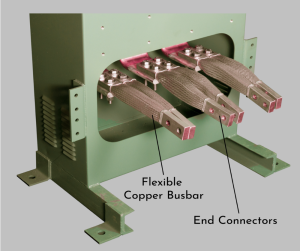How do 2023 NEC rules impact Flexible Bus System overcurrent protection?
Overview
Overcurrent protection serves as the fundamental safeguard for power equipment. Flexible Bus Systems (FBS) integrate the physical flexibility of cables with the high amperage capabilities of bus bars into a single equipment solution. FBS is designed for versatile application across various scenarios. However, these versatile qualities of FBS complicate the selection process for a universal overcurrent protection scheme, requiring consideration of multiple factors outlined in NEC Section 371.17.
capabilities of bus bars into a single equipment solution. FBS is designed for versatile application across various scenarios. However, these versatile qualities of FBS complicate the selection process for a universal overcurrent protection scheme, requiring consideration of multiple factors outlined in NEC Section 371.17.
Applying the 2023 Code
Flexible Bus Systems (FBS) have recently emerged in the power industry as versatile, high-capacity connectors. They offer both the flexibility to accommodate sharp turns and the rigidity required for high-amperage applications, making them a valuable innovation. The introduction of FBS enables the design of compact, high-capacity systems and smaller devices, such as transformers, switchboards, and switchgears. However, the adoption of FBS also presents challenges, including the selection of an appropriate overcurrent protection scheme. Being a relatively new technology, FBS lacked standardized overcurrent protection guidelines in previous editions of the NEC. To address this, the NEC 2023 edition has defined overcurrent protection requirements for FBS in Section 371.17. These standardized practices will facilitate the development of uniform approaches to FBS overcurrent protection schemes and procedures within the industry.
What’s New for the 2023 NEC?
2020 NEC
In the 2020 NEC, no reference can be found regarding the overprotection requirements for Flexible Bus Systems (FBS) due to their recent introduction to the industry.
2023 NEC
In the 2023 NEC, Section 371.17 has been introduced to standardize overcurrent protection schemes and procedures for flexible bus systems. The new Section now reads as follows:
371.17 Overcurrent Protection
Overcurrent protection shall be provided in accordance with 371.17(A) through (G).
(A) Rating of Overcurrent Protection – Services
Flexible bus systems installed for services shall be protected against overcurrent in accordance with 230.90.
(B) Rating of Overcurrent Protection – Feeders
Flexible bus systems installed as feeders shall be protected against overcurrent in accordance with 215.3.
Exception: The applicable requirements of 240.4 shall be permitted.
(C) Rating of Overcurrent Protection – Branch Circuits
Flexible bus systems installed as branch circuits shall be protected against overcurrent in accordance with 210.20.
Exception: The applicable requirements of 240.4 shall be permitted.
(D) Transformer Secondary Flexible Bus Systems
Flexible bus systems installed on a transformer secondary to the disconnect and overcurrent protection device shall be protected from overcurrent in accordance with 240.21 (C).
(E) Flexible Bus Systems from Generator Terminals
Flexible bus systems installed from generator terminals that meet the size requirement in 445.13 shall be permitted to be protected against overload by the generator overload protective device(s) required by 445.12.
(F) Flexible Bus Systems from Battery Terminals
Flexible bus systems installed for battery systems shall be protected from overcurrent in accordance with 240.21 (H).
(G) Reduction in Size of Flexible Bus Systems
Overcurrent protection shall be required at the point where flexible bus systems are reduced in size.
Exception: For industrial establishments only, omission of overcurrent protection shall be permitted at points where a flexible bus system is reduced in size, provided that the length of the flexible bus system having a reduced size does not exceed 15 m (50 ft) and has a current rating at least equal to one-third the rating or setting of the overcurrent device ahead of the point of connection and provided that such a flexible bus system is free from contact with combustible material.
